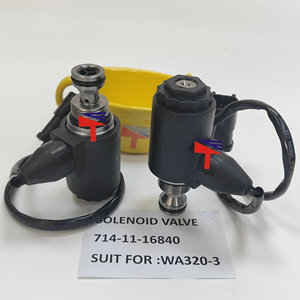(7835 products available)






































































































































































A 4v110 06 solenoid valve controls compressed air flow in pneumatic systems. Following are some ways in which they differ from one another:
Clean regularly:
Use a clean, dry cloth to wipe the surface of the 4v110 06 solenoid valve to remove dust and dirt. Avoid using water and other liquids to clean, so as not to damage the valve.
Avoid external force;
Do not pull, press, or hit the solenoid valve to avoid damaging it or affecting its performance.
Keep dry;
Keep the surrounding environment of the solenoid valve dry and avoid high humidity and a damp atmosphere to prevent valve faults.
Avoid overheating:
Keep away from high temperature and heat sources. Solenoid valves are sensitive to temperature; high temperature may damage their internal components.
Avoid corrosion:
Keep away from corrosive substances. Corrosive substances can damage the material of the solenoid valve, leading to its failure to function properly.
Regular inspection:
Regularly check the working state of the solenoid valve, such as the electrical connection is firm, working noise is normal, etc., to find problems in time to deal with them.
The 4v110 06 solenoid valve operates in different scenarios. Here are some of them:
When selecting solenoid valves, several important factors to consider will be discussed below.
Downstream pressure
The downstream pressure will be discussed first before the upstream pressure. Since the pressure within a system should always be above the atmospheric pressure to avoid system failure, it is imperative to know the downstream pressure needed to perform the intended task with the solenoid valve. Solenoid valves will be desired to close against the spring force of the diaphragm and the downstream pressure. Selecting a solenoid valve whose diaphragm will not give way to the spring force will ensure the system achieves its desired pressure.
Upstream pressure
The source of pressure will be looked into next. Unlike the downstream pressure, the upstream pressure must allow the solenoid valve to function normally. The solenoid valve requires a certain amount of pressure to allow it to start utilizing the pressure from its immediate environment. The disproportionate amounts of pressure create a significant flow area for the solenoid valve to perform its function.
Orifice
A significant enough flow area has to be created for the solenoid valve to do its work. The orifice of the solenoid valve directly affects the flow area created. From the above two discussions, it can be gathered that the orifice size of the solenoid valve must be large enough to allow sufficient flow area for the system to achieve its purpose.
Cost
The direct cost of achieving elevated or needful pressures and the indirect costs associated with them also require careful thought. The cost is not only monetary but also physical and environmental. All system constituents will have to be studied as to how they will react and function under the applicable conditions. Will they be able to take the pressure? The system will need to be studied, and adjustments will need to be made to ensure all things work well together, and the required things are there to achieve optimal functioning at the cost of a better solenoid valve with a greater orifice.
Q1: Are 4v110 solenoid valves AC or DC?
A1: The 4v110 solenoid valve is purely a DC solenoid valve. Nonetheless, there exist AC and DC solenoid valves in different models and specifications.
Q2: What are the benefits of using 4v110 06 solenoid valves?
A2: The function of the solenoid valve is to control the flow direction. Therefore, it is essential to control the power supply. Solenoid valves are swiftly opened and shut, therefore allowing for management of high volumes of fluid in a system rapidly. The control of high volumes of fluids at high pressure in a system enables the system to function excellently. Solenoid valves are easy to automate when linking up with a sensor or a switch in a circuit. Therefore, they are highly recommended for use in systems that would frequently require the manual input of a person to make the system function.
Q3: Can a 4v110 06 solenoid valve be repaired?
A3: In most cases, solenoid valves are not repairable. If they are damaged, they can be replaced with new ones.
Q4: How long does a 4v110 06 solenoid valve last?
A4: The lifespan of a solenoid valve may vary depending on the material, use, operating environment, and maintenance practices. Normally, if a solenoid is properly taken care of and used in the right applications, it can last up to 5 to 10 years or even more.